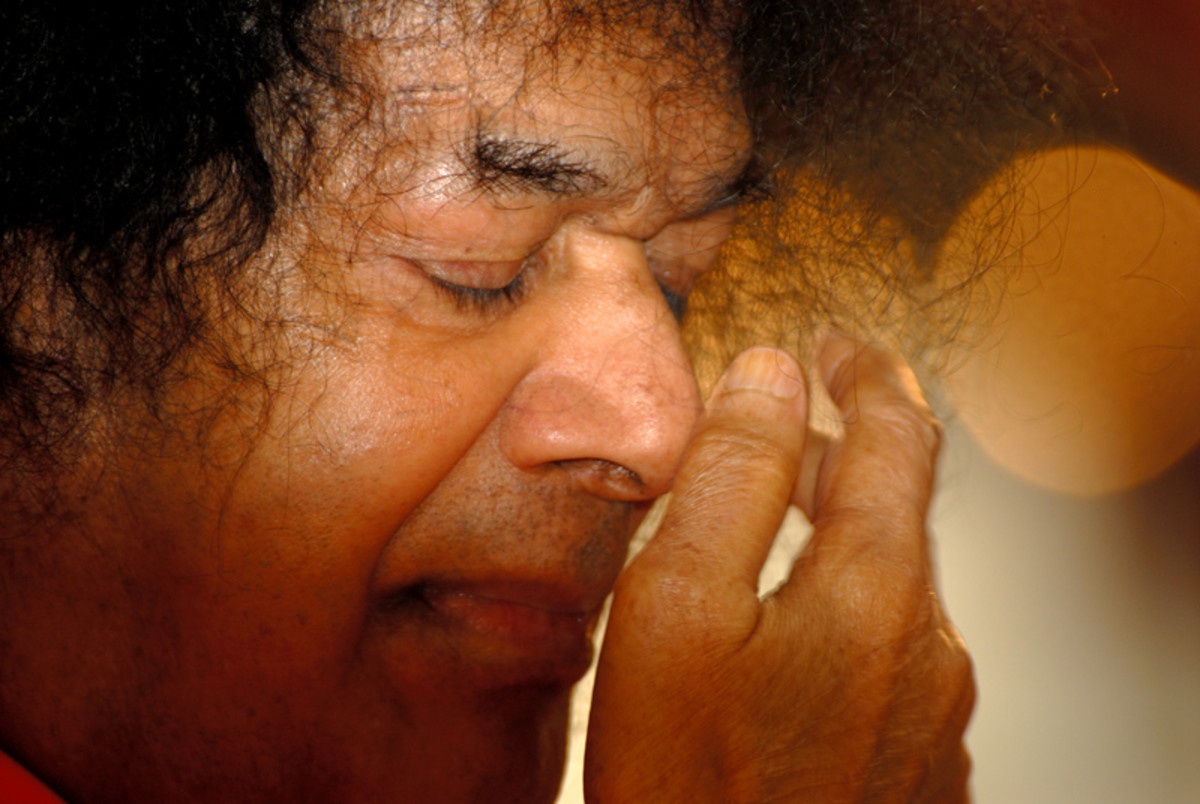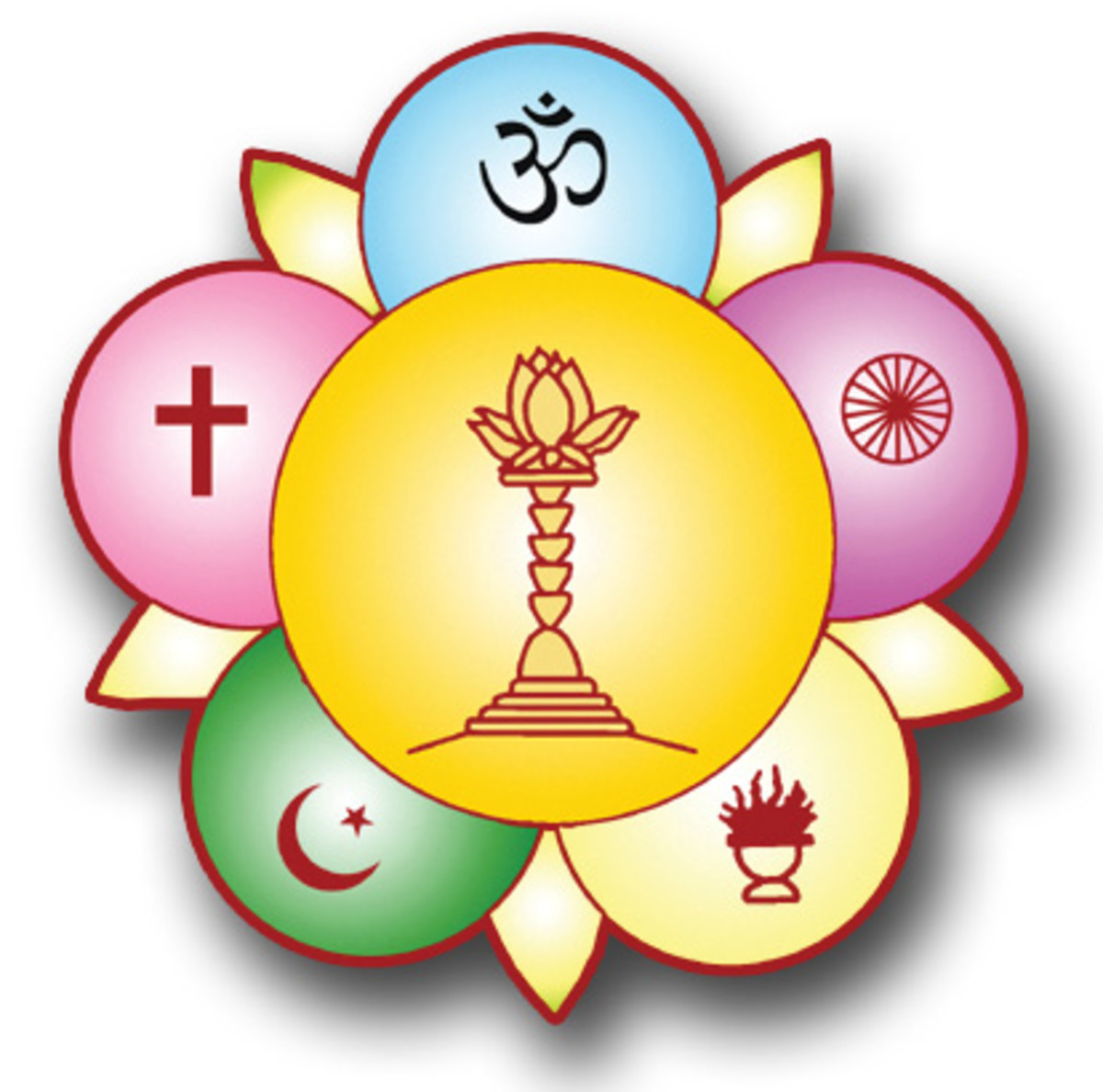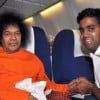Sri Sathya Sai Baba 1926 - 2011.

¿Un profeta?
Los detractores dicen que 'juego de manos' y 'trucos de magia' le ganaron seguidores que eran crédulos e ingenuos. Los devotos dicen que '' las manifestaciones físicas le ganaron acérrimos críticos que estaban tan ciegos y duros de corazón, que se negaron a ver los millones de vidas se veian afectada positivamente. La vida y la historia de Sri Sathya Sai Baba parece recordar a el árbol proverbial cargado con frutas - que siempre recibe piedras. Mientras que algunas piedras fueron lanzadas para disfrutar y saborear las frutas dulces, algunas fueron lanzadas porque parece tan tentador simplemente hacerlo!
Por supuesto, no puede ser aceptado como un profeta. ¿Qué religión estableció él? Él acaba de unir a la humanidad bajo los principios de la hermandad del hombre y la paternidad de Dios. En un mundo que se encuentra al borde de un desastre religioso debido a fanáticos egocéntricos, exhortó a un hindú a ser un mejor hindú, un musulmán para ser un mejor musulmán y un cristiano para ser un mejor cristiano. El símbolo que diseñó para representar a la organización tenía simbolos de todas las principales religiones del mundo.

Todos, desde los monjes tibetanos hasta los eruditos islámicos, los yoguis hindúes hasta los padres cristianos, los gurús sijs y los predicadores budistas, lo visitaban y eran recibidos cálidamente por sus seguidores. Se sorprendieron con su profundo conocimiento de su religión, y a menudo admiraban las ideas que proporcionaba. La serie de libros 'Vahini' de la que es autor transmite las más grandes verdades espirituales en términos fáciles y prácticos: ¡todo lo que uno tiene que hacer es elegir uno y leerlo! Pero aún así, ¿cómo puede ser un profeta cuando no comenzó una nueva religión?
Espíritu detrás del ritual - el espiritual!
El mundo lo reconoce por sus proyectos masivos de bienestar social: esquemas de agua potable, hospitales de súper especialidades y educación superior gratuita. Los críticos también reconocen ese hecho, mientras los seguidores lo presentan como prueba de su divinidad. Y en eso, ambos parecen perder el punto. Sathya Sai Baba nunca creyó en unos pocos edificios (por grandes e imponentes) haciendo del mundo un lugar mejor ya que creía en algunas ideas.
Las escuelas y la universidad fueron el resultado de la idea de que la educación es un proceso de sacar de dentro lo que ya está latente en un individuo. Y ese tesoro latente es el amor, la verdad, la conducta correcta, la paz, el entendimiento y la compasión, que exhortó a todos los estudiantes a poner en practica. El Svaya Sai Grama seva o servicio a la aldea, donde cada estudiante pasa una semana yendo a las aldeas distribuyendo comida y ropa, fue instituido no tanto para servir a los pobres sino para absorber la idea, el espíritu y la alegría de servicio en el estudiante. Como rector de la Universidad, siempre aconsejó a los estudiantes que se hicieran un buen nombre para ellos, sus padres y su Alma Mater. Les dijo que habían recibido una buena educación sin una tarifa porque la educación es patrimonio de todos y no necesitan sentirse agradecidos por ello. Pero la gratitud, sin embargo, se convirtió en una parte de la vida de cada estudiante a medida que se fue perpetuando este servicio.
Las escuelas y la universidad fueron el resultado de la idea de que la educación es un proceso de sacar de dentro lo que ya está latente en un individuo. Y ese tesoro latente es el amor, la verdad, la conducta correcta, la paz, el entendimiento y la compasión, que exhortó a todos los estudiantes a poner en practica. El Svaya Sai Grama seva o servicio a la aldea, donde cada estudiante pasa una semana yendo a las aldeas distribuyendo comida y ropa, fue instituido no tanto para servir a los pobres sino para absorber la idea, el espíritu y la alegría de servicio en el estudiante. Como rector de la Universidad, siempre aconsejó a los estudiantes que se hicieran un buen nombre para ellos, sus padres y su Alma Mater. Les dijo que habían recibido una buena educación sin una tarifa porque la educación es patrimonio de todos y no necesitan sentirse agradecidos por ello. Pero la gratitud, sin embargo, se convirtió en una parte de la vida de cada estudiante a medida que se fue perpetuando este servicio.
Los hospitales y los proyectos de agua surgieron porque sintió que el agua y cuidados médicos eran el derecho de las personas. No deben ser una compra costosa. Se ha escrito mucho acerca de estos proyectos, pero muy poco se ha dicho sobre cómo quería que la gente debe empaparse del espíritu de servicio y amor. “Cuando una espina se clava el pie, la mano pasa automáticamente a extraerla sin sentir que está ayudando a los pies. Asi es cómo el servicio tiene que ser traducido “.

Y, sin embargo, dicen que se rodeó de los ricos, los populares y de la élite.! Esa forma de hablar sólo muestra que las personas que lo comentan, no se han tomado la molestia de visitarlo ni una sola vez. Si no se conocen sus interacciones con los pobres, los que sufren y los necesitados, es sólo porque la atención no se ha puesto para ellos. La visita de Sachin Tendulkar para rendirle homenaje fue salpicada a través de los medios de comunicación en todas sus formas, pero no vemos ninguna mención del proyecto de viviendas masivas que hizo para las víctimas de las inundaciones de Orissa, o los programas Village integradas, para las regiones tribales del este y el oeste de Godavari en Andhra Pradesh.
Detractor y devoto; la teoría y la experiencia
Y cuando se trata de la pregunta, "¿Quién eres? ¿Eres Dios? ", Su respuesta siempre fue:" Averigua quién eres ". Te darás cuenta de que tú también eres Dios. "La divinidad no se usa, tiene que ser aceptada por las personas. Seamos honestos y justos. Si alguno de nosotros reclama la divinidad ascendiendo a un púlpito, ¿cuántos seguidores tendremos en, digamos, 80 años a partir de ahora? Comenzar como un niño pobre en un pueblo propenso a la sequía que no había escuchado los sonidos de un vehículo de motor, tener millones de seguidores en todo el mundo es un logro. Él tiró sus libros de historia un día y hoy, él ha entrado en los libros de historia. Pero cuando se trataba de la Divinidad, él siempre empujaba a Dios hacia la gente diciendo: "Tú eres Dios. simplemente no te das cuenta de ello. "Eso recuerda a" En Dios piensas, Dios eres, polvo piensas, polvo eres "¿no?
"Las generaciones venideras apenas creerán que alguien asi alguna vez en carne y hueso caminó sobre esta tierra", fue lo que Albert Einstein dijo de Mahatma Gandhi. Las increíbles historias de la gracia de Bhagavan Sri Sathya Sai Baba son tales que, incluso cuando caminó sobre la tierra, a la gente le resultaba difícil de creer. Muchos vinieron, vieron con sus propios ojos, experimentaron en su propio ser y lo aceptaron como su Señor. Sin embargo, algunos optaron por quedarse en sus propias pequeñas cooperativas, felices de acumular críticas mordaces. "¿Por qué explorar algo que es imposible?" Parece ser el teorema. "Cuando algo es imposible, incluso si millones hablan en términos elogiosos al respecto, debe ser falso y todos deben estar locos" es el corolario automático.
No hay diferencia entre el detractor y el devoto cuando se trata de su pasión, intensidad y creencia. Sin embargo, hay una gran diferencia. Mientras que el primero cita informes, periódicos, artículos y relatos escritos para enfatizar las críticas, ¡este último solo habla de una profunda convicción nacida de la experiencia personal! Y eso muestra por qué uno parece sonar más fuerte para defender una idea, mientras que el otro parece derretirse en el silencio cuando se enfrentan. ¡La lógica de la cabeza nunca parece reunir suficiente impulso para dominar la convicción del corazón!
Y es por eso que aquellos que lo han experimentado en sus corazones se niegan a aceptar que ha "muerto". Para ellos, él vive para siempre y reciben orientación y ayuda cuando lo necesitan. No tienen dudas al respecto y no ven la necesidad de convencer a nadie más al respecto. Ese es el poder de lo que uno ha observado y experimentado. Recuerda a Albert Einstein cuando se burló de su propuesta del efecto fotoeléctrico. Cuando la ciencia había evolucionado durante más de un siglo para demostrar que la luz era una onda y no una partícula, ¡aquí había alguien considerado un genio que basaba su efecto en la premisa de que la luz era una partícula! El efecto fotoeléctrico que dio en 1905 ganó el premio Nobel en 1921.
Cuando la teoría y el experimento parecen chocar con la observación y la experiencia, ¿no deberíamos buscar nuestra propia experiencia?
2011...2018... busquemos la experiencia, desde el corazón, antes de juzgar...
No hay diferencia entre el detractor y el devoto cuando se trata de su pasión, intensidad y creencia. Sin embargo, hay una gran diferencia. Mientras que el primero cita informes, periódicos, artículos y relatos escritos para enfatizar las críticas, ¡este último solo habla de una profunda convicción nacida de la experiencia personal! Y eso muestra por qué uno parece sonar más fuerte para defender una idea, mientras que el otro parece derretirse en el silencio cuando se enfrentan. ¡La lógica de la cabeza nunca parece reunir suficiente impulso para dominar la convicción del corazón!
Y es por eso que aquellos que lo han experimentado en sus corazones se niegan a aceptar que ha "muerto". Para ellos, él vive para siempre y reciben orientación y ayuda cuando lo necesitan. No tienen dudas al respecto y no ven la necesidad de convencer a nadie más al respecto. Ese es el poder de lo que uno ha observado y experimentado. Recuerda a Albert Einstein cuando se burló de su propuesta del efecto fotoeléctrico. Cuando la ciencia había evolucionado durante más de un siglo para demostrar que la luz era una onda y no una partícula, ¡aquí había alguien considerado un genio que basaba su efecto en la premisa de que la luz era una partícula! El efecto fotoeléctrico que dio en 1905 ganó el premio Nobel en 1921.
Cuando la teoría y el experimento parecen chocar con la observación y la experiencia, ¿no deberíamos buscar nuestra propia experiencia?
2011...2018... busquemos la experiencia, desde el corazón, antes de juzgar...
© 2012 Aravind Balasubramanya
**************************************************************************************************
 Source
Source
 A colored version of the logo Baba designed to represent the unity of all faiths.
A colored version of the logo Baba designed to represent the unity of all faiths.
 Actually commonsense right? | Source
Actually commonsense right? | Source
Sri Sathya Sai Baba 1926 - 2011

A prophet?
The detractors say that ‘sleight of hand’ and ‘magic tricks’ won him followers who were gullible and naïve. The devotees say that ‘physical manifestations’ earned him die-hard critics who were so blind and hard-hearted that they refused to see the millions of lives he positively affected. The life and history of Sri Sathya Sai Baba seems to remind one of the proverbial tree laden with fruit - it always receives stones. While some stones were cast to enjoy and relish the sweet fruits, some were cast because it seems so tempting to just do it!
Of course, he cannot be accepted as a prophet. What religion did he establish? He just brought together humanity under the principles of the brotherhood of man and the fatherhood of god. In a world that stands on the brink of religious disaster due to self-centered zealots, he exhorted a Hindu to be a better Hindu, a Muslim to be a better Muslim and a Christian to be a better Christian. The symbol that he designed to represent the organisation had representations from all the major religions of the world.
Of course, he cannot be accepted as a prophet. What religion did he establish? He just brought together humanity under the principles of the brotherhood of man and the fatherhood of god. In a world that stands on the brink of religious disaster due to self-centered zealots, he exhorted a Hindu to be a better Hindu, a Muslim to be a better Muslim and a Christian to be a better Christian. The symbol that he designed to represent the organisation had representations from all the major religions of the world.

Everyone from the Tibetan Monks to the Islamic scholars, Hindu yogis to Christian fathers, Sikh gurus to Buddhist preachers visited him and were received warmly with love by his followers. They were amazed with his deep understanding of their religion and often admired the insights he provided. The ‘Vahini’ series of books that he authored convey the greatest spiritual Truths in easy and practical terms - all one has to do is to pick one and read it! But still, how can he be a prophet when he did not start a new religion?
Spirit behind the ritual - the Spiritual!
The world credits him for his massive social welfare projects - drinking water schemes, super specialty hospitals and free higher education. The critics also acknowledge that fact while the followers parade it as proof of his divinity. And in that, both seem to miss the point. Sathya Sai Baba never believed in a few buildings (however big or grand) making the world a better place as he believed in a few ideas.
The schools and university were a result of the idea that Education is a process of bringing out from within what is already latent in an individual. And that latent treasure is love, truth, right conduct, peace, understanding and compassion which he exhorted every student to make patent. The Sathya Sai Grama seva or village service, where every student spends a week going to villages distributing food and clothes, was instituted not so much to serve the poor but to imbibe the idea, spirit and joy of service in the student. As the chancellor of the University, he always advised the students to get a good name for themselves, their parents and their Alma Mater. He told them that they had received good education without a fee because education is everyone’s birthright and they need not feel grateful about it. But the gratitude, however, became a part of every student’s life as he/she went about perpetuating this service.
The schools and university were a result of the idea that Education is a process of bringing out from within what is already latent in an individual. And that latent treasure is love, truth, right conduct, peace, understanding and compassion which he exhorted every student to make patent. The Sathya Sai Grama seva or village service, where every student spends a week going to villages distributing food and clothes, was instituted not so much to serve the poor but to imbibe the idea, spirit and joy of service in the student. As the chancellor of the University, he always advised the students to get a good name for themselves, their parents and their Alma Mater. He told them that they had received good education without a fee because education is everyone’s birthright and they need not feel grateful about it. But the gratitude, however, became a part of every student’s life as he/she went about perpetuating this service.
The hospitals and water projects arose because he felt that water and medical care were people’s right. They should not be a costly purchase. Much has been written about these projects but very little has been said about how he wanted people to imbibe the spirit of service and love. “When a thorn pricks the foot, the hand automatically goes to remove it without feeling that it is helping the foot. That is how service has to be rendered.”

And yet, they say that he surrounded himself with the rich, the popular and the elite! Such talk only shows that people indulging in it have not bothered to visit him even once. If his interactions with the poor, the suffering and the helpless are not known, it is only because attention has not been drawn to them. Sachin Tendulkar’s visit to pay homage to him was splashed across media in every form but we see no mention of the massive housing project that he made for the flood victims of Orissa or the Village Integrated programmes he charted for the tribal regions of East and West Godavari in Andhra Pradesh.
Detractor and devotee; theory and experience
And when it came to the question, “Who are you? Are you God?”, his reply always was,
“Find out who you are. You will realize that you too are God.”
“Find out who you are. You will realize that you too are God.”
Godhood is not donned, it has to be accepted by people. Let us be honest and fair. If any of us claim godhood by ascending a pulpit, how many followers will we have in, say, 80 years from now? Starting as a poor boy in a drought-prone village that had not heard the sounds of a motor vehicle, having millions of followers world-wide is some achievement. He threw away his history books one day and today, he has entered history books. But when it came to Godhood, he always thrust back Godhood on the people saying,
“You are all God. you just are not aware of it."
That is reminiscent of “God you think, God you are; Dust you think, dust you are” isn't it?
That is reminiscent of “God you think, God you are; Dust you think, dust you are” isn't it?
“Generations to come will scarce believe that such a one as this ever in flesh and blood walked upon this earth”, was what Albert Einstein said of Mahatma Gandhi. The amazing stories of grace of Bhagawan Sri Sathya Sai Baba are such that even when he walked upon the earth, people found it hard to believe. Many came, saw with their own eyes, experienced in their own beings and accepted him as their Lord. Some however chose to stay in their own little coops, happy to heap scathing criticism.
“Why explore something that is impossible?” seems to be the theorem. “When something is impossible, even if millions speak in glowing terms about it, it must be false and everyone must be crazy” is the automatic corollary!
There is no difference between the detractor and devotee when it comes to his/her passion, intensity and belief.There is one major difference however. While the former quotes reports, newspapers, articles and written accounts to emphasize the criticism, the latter only speaks of deep conviction born from personal experience! And that shows why one seems to blare louder to make a point while the other seems to melt into silence when confronted. The rationale of the head never seems to gather enough momentum to overpower the conviction of the heart!
And that is why, those that have experienced him in their hearts refuse to accept that he has ‘died’. For them, he lives on forever and they receive guidance and help whenever they need. They have no doubts in that and they see no need to convince anyone else about it. That is the power of what one has observed and experienced. Reminds one of Albert Einstein when he was scoffed at his proposal of the photoelectric effect. When science had evolved over a century to prove that light was a wave and not a particle, here was someone considered a genius who based his effect on the premise that light was a particle! The photoelectric effect which he gave in 1905 won the Nobel prize in 1921.
When theory and experiment seem to clash with observation and experience, should we not go with the experience?
“Why explore something that is impossible?” seems to be the theorem. “When something is impossible, even if millions speak in glowing terms about it, it must be false and everyone must be crazy” is the automatic corollary!
There is no difference between the detractor and devotee when it comes to his/her passion, intensity and belief.There is one major difference however. While the former quotes reports, newspapers, articles and written accounts to emphasize the criticism, the latter only speaks of deep conviction born from personal experience! And that shows why one seems to blare louder to make a point while the other seems to melt into silence when confronted. The rationale of the head never seems to gather enough momentum to overpower the conviction of the heart!
And that is why, those that have experienced him in their hearts refuse to accept that he has ‘died’. For them, he lives on forever and they receive guidance and help whenever they need. They have no doubts in that and they see no need to convince anyone else about it. That is the power of what one has observed and experienced. Reminds one of Albert Einstein when he was scoffed at his proposal of the photoelectric effect. When science had evolved over a century to prove that light was a wave and not a particle, here was someone considered a genius who based his effect on the premise that light was a particle! The photoelectric effect which he gave in 1905 won the Nobel prize in 1921.
When theory and experiment seem to clash with observation and experience, should we not go with the experience?
© 2012 Aravind Balasubramanya

